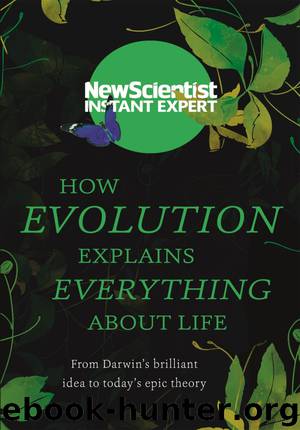How Evolution Explains Everything About Life by New Scientist

Author:New Scientist
Language: eng
Format: epub
Publisher: Quercus
Published: 2017-09-04T04:00:00+00:00
New species in next to no time
In the right circumstances, even new species can evolve in next to no time. In 1866, farmers in the US reported that an unknown maggot was attacking their apples, a crop introduced two centuries earlier. Entomologist Benjamin Walsh suggested that the ‘apple maggot’ was a strain of the native hawthorn fly that had switched diets. Walsh had previously suggested this kind of process could lead to speciation.
We now know that Walsh was right. Genetic studies have shown that the hawthorn fly appears to be in the process of splitting into two species. What’s more, the parasitic wasps whose larvae feed on the maggots are also splitting into two species.
More examples keep turning up. A species of fish in a lake in Nicaragua has split in two in only 100 years. The new variety has evolved a narrower, pointier head and fatter lips, ideal for nibbling insects from crevices. The original variety has sturdier jaws and extra teeth to crack snail shells. Lab studies suggest the strains do not mate with each other even when put together, which would mean they are on their way to becoming separate species.
Yet another example comes from the famous Galapagos finches. Since 1973, husband-and-wife team Peter Grant and Rosemary Grant have been studying the finches on the island of Daphne Major, in one of the few long-term studies of ongoing evolution. They reported in 2010 that a new species of finch might be evolving. In 1981, a medium ground finch (Geospizafortis) from another island reached Daphne Major and interbred with the local birds, producing offspring with unusual beaks and songs. After four generations, following a severe drought that killed many birds, this new strain stopped interbreeding with the other finches. It’s not clear why interbreeding stopped, but if the birds continue to shun the locals they will become a new species.
As the list of examples grew, Kinnison and his colleagues began to pull them together and look at what they tell us about evolution. ‘We started to realize that maybe this was not the exception, that this was the norm.’ In fact, he now argues that the term ‘rapid evolution’ is misleading, because it implies evolution is normally slow. Instead, he and his colleagues prefer ‘contemporary evolution’. Of course, proving that contemporary evolution is the norm in a world of millions of species is a challenge.
If rapid evolution really is the norm, how come fossil and genetic studies suggest it is slow? The answer may be that new species and traits not only evolve rapidly, they also disappear fast too and do not leave their mark on the fossil or genetic record.
Download
This site does not store any files on its server. We only index and link to content provided by other sites. Please contact the content providers to delete copyright contents if any and email us, we'll remove relevant links or contents immediately.
The Lonely City by Olivia Laing(4713)
Animal Frequency by Melissa Alvarez(4369)
All Creatures Great and Small by James Herriot(4196)
Walking by Henry David Thoreau(3863)
Exit West by Mohsin Hamid(3748)
Origin Story: A Big History of Everything by David Christian(3594)
COSMOS by Carl Sagan(3518)
How to Read Water: Clues and Patterns from Puddles to the Sea (Natural Navigation) by Tristan Gooley(3376)
Hedgerow by John Wright(3244)
How to Read Nature by Tristan Gooley(3217)
The Inner Life of Animals by Peter Wohlleben(3204)
How to Do Nothing by Jenny Odell(3204)
Project Animal Farm: An Accidental Journey into the Secret World of Farming and the Truth About Our Food by Sonia Faruqi(3145)
Origin Story by David Christian(3121)
Water by Ian Miller(3093)
A Forest Journey by John Perlin(3012)
The Plant Messiah by Carlos Magdalena(2842)
A Wilder Time by William E. Glassley(2794)
Forests: A Very Short Introduction by Jaboury Ghazoul(2767)
